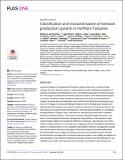Files in this item
Classification and characterisation of livestock production systems in northern Tanzania
Item metadata
| dc.contributor.author | de Glanville, William A. | |
| dc.contributor.author | Davis, Alicia | |
| dc.contributor.author | Allan, Kathryn J. | |
| dc.contributor.author | Buza, Joram | |
| dc.contributor.author | Claxton, John R. | |
| dc.contributor.author | Crump, John A. | |
| dc.contributor.author | Halliday, Jo E. B. | |
| dc.contributor.author | Johnson, Paul C. D. | |
| dc.contributor.author | Kibona, Tito J. | |
| dc.contributor.author | Mmbaga, Blandina T. | |
| dc.contributor.author | Swai, Emmanuel S. | |
| dc.contributor.author | Uzzell, Christopher B. | |
| dc.contributor.author | Yoder, Jonathan | |
| dc.contributor.author | Sharp, Jo | |
| dc.contributor.author | Cleaveland, Sarah | |
| dc.date.accessioned | 2021-01-08T10:30:13Z | |
| dc.date.available | 2021-01-08T10:30:13Z | |
| dc.date.issued | 2020-12-30 | |
| dc.identifier | 272117505 | |
| dc.identifier | 1dcc5db9-ec32-4e41-8f9d-d36772a271f1 | |
| dc.identifier | 85098883557 | |
| dc.identifier | 000605651300017 | |
| dc.identifier.citation | de Glanville , W A , Davis , A , Allan , K J , Buza , J , Claxton , J R , Crump , J A , Halliday , J E B , Johnson , P C D , Kibona , T J , Mmbaga , B T , Swai , E S , Uzzell , C B , Yoder , J , Sharp , J & Cleaveland , S 2020 , ' Classification and characterisation of livestock production systems in northern Tanzania ' , PLoS ONE , vol. 15 , no. 12 , e0229478 . https://doi.org/10.1371/journal.pone.0229478 | en |
| dc.identifier.issn | 1932-6203 | |
| dc.identifier.other | RIS: urn:9A33DA96C8A6B5DC8CD648621CA6C367 | |
| dc.identifier.other | ORCID: /0000-0001-5805-4296/work/86538475 | |
| dc.identifier.uri | https://hdl.handle.net/10023/21246 | |
| dc.description | Funding: This research was funded by the Biotechnology and Biological Sciences Research Council, Department for International Development, the Economic & Social Research Council, the Medical Research Council, the Natural Environment Research Council and the Defence Science & Technology Laboratory, under the “Zoonoses and Emerging Livestock Systems” (ZELS) programme (BB/L018926/1 and BB/L018845/1). KJA received support from the Wellcome Trust (096400/Z/11/Z). CBU received support from a Lord Kelvin/Adam Smith (LKAS) PhD scholarship. | en |
| dc.description.abstract | Livestock keepers in sub-Saharan Africa face a range of pressures, including climate change, land loss, restrictive policies, and population increase. Widespread adaptation in response can lead to the emergence of new, non-traditional typologies of livestock production. We sought to characterise livestock production systems in two administrative regions in northern Tanzania, an area undergoing rapid social, economic, and environmental change. Questionnaire and spatial data were collected from 404 livestock-keeping households in 21 villages in Arusha and Manyara Regions in 2016. Multiple factor analysis and hierarchical cluster analysis were used to classify households into livestock production systems based on household-level characteristics. Adversity-based indicators of vulnerability, including reports of hunger, illness, and livestock, land and crop losses were compared between production systems. Three distinct clusters emerged through this process. The ethnic, environmental and livestock management characteristics of households in each cluster broadly mapped onto traditional definitions of ‘pastoral’, ‘agro-pastoral’ and ‘smallholder’ livestock production in the study area, suggesting that this quantitative classification system is complementary to more qualitative classification methods. Our approach allowed us to demonstrate a diversity in typologies of livestock production at small spatial scales, with almost half of study villages comprising more than one production system. We also found indicators of change within livestock production systems, most notably the adoption of crop agriculture in the majority of pastoral households. System-level heterogeneities in vulnerability were evident, with agro-pastoral households most likely to report hunger and pastoral households most likely to report illness in people and livestock, and livestock losses. We demonstrate that livestock production systems can provide context for assessing household vulnerability in northern Tanzania. Policy initiatives to improve household and community well-being should recognise the continuing diversity of traditional livestock production systems in northern Tanzania, including the diversity that can exist at small spatial scales. | |
| dc.format.extent | 25 | |
| dc.format.extent | 1243526 | |
| dc.language.iso | eng | |
| dc.relation.ispartof | PLoS ONE | en |
| dc.subject | G Geography. Anthropology. Recreation | en |
| dc.subject | DAS | en |
| dc.subject | SDG 2 - Zero Hunger | en |
| dc.subject | SDG 13 - Climate Action | en |
| dc.subject.lcc | G | en |
| dc.title | Classification and characterisation of livestock production systems in northern Tanzania | en |
| dc.type | Journal article | en |
| dc.contributor.institution | University of St Andrews. School of Geography & Sustainable Development | en |
| dc.contributor.institution | University of St Andrews. Geographies of Sustainability, Society, Inequalities and Possibilities | en |
| dc.identifier.doi | 10.1371/journal.pone.0229478 | |
| dc.description.status | Peer reviewed | en |
This item appears in the following Collection(s)
Items in the St Andrews Research Repository are protected by copyright, with all rights reserved, unless otherwise indicated.

